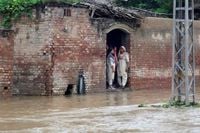Heavy monsoon rains have once again brought devastation to South Asia, with Pakistan and India grappling with deadly floods, mass evacuations, and a rare moment of diplomatic contact between two nuclear-armed rivals. The crisis, which has unfolded in late August 2025, underscores not just the immediate humanitarian emergency, but also the deep-seated tensions and fragile agreements that govern water sharing in the region.
Pakistan’s National Disaster Management Authority (NDMA) announced on August 26, 2025, that more than 14,000 people had been evacuated from the Kasur district in Punjab province, while over 89,000 residents were moved to safer ground from the city of Bahawalnagar near the Indian border. According to the Associated Press, these urgent measures followed India’s decision to release water from overflowing dams and swollen rivers into low-lying border regions, a move that threatened to exacerbate already severe flooding on the Pakistani side.
The NDMA issued an advance alert regarding a surge in the Sutlej River and mounting flood risks, urging residents to steer clear of rivers, streams, and low-lying areas, and to heed warnings delivered via media, mobile phones, and the authority’s disaster alert app. The evacuation drive was prompted by a formal warning from India, which, notably, was communicated through diplomatic channels rather than the traditional Indus Waters Commission. This marked the first public diplomatic contact between New Delhi and Islamabad in months, as reported by Reuters and the Associated Press.
“India shared a warning on possible cross-border flooding with neighbour Pakistan on ‘humanitarian grounds’ and not under the water-sharing Indus Waters Treaty between the old enemies,” a government source told Reuters on August 24, 2025. The warning came after heavy rains battered the Jammu and Kashmir region, which borders Pakistan and is claimed in its entirety by both countries.
On the ground, the impact of the monsoon has been catastrophic. Since June 26, 2025, floods triggered by seasonal rains have killed more than 800 people in Pakistan, according to the NDMA. In Indian-administered Jammu and Kashmir, at least 65 people have died and hundreds have been displaced, Indian officials told the Associated Press. Homes have been inundated, roads and bridges washed away, and water levels in multiple rivers continued to rise as of August 26, with the Indian Meteorological Department forecasting that rains would persist until late Tuesday.
In Pakistan’s northwest, the devastation was particularly acute in Buner district, where a sudden cloudburst earlier this month killed more than 300 people. Residents there complained of receiving no warning before the flash floods struck. Officials explained that the disaster was caused by a cloudburst, which could not have been predicted, and many victims had been living along natural water pathways. Across the nation, the toll has been grim, with the specter of the 2022 floods—when a third of Pakistan was submerged and 1,739 people lost their lives—looming large.
Scientists and weather forecasters have pointed to climate change as a key driver behind the increasingly heavy rains and frequent cloudburst events in the region. “Pakistan’s annual monsoon season runs from July through September,” the Associated Press noted, “and scientists have blamed climate change for heavier rains in recent years.” The 2025 monsoon, with its above-normal rainfall and multiple cloudburst floods, has only heightened fears of a repeat of the catastrophic events of three years prior.
The diplomatic dimensions of this crisis are no less complex. The Indus Waters Treaty, brokered by the World Bank in 1960, has long governed the sharing of the Indus River system: India controls the eastern rivers (Ravi, Sutlej, Beas), while Pakistan oversees the western rivers (Jhelum, Chenab, Indus). The treaty had survived two wars, a major border skirmish, and countless periods of tension. However, in April 2025, India suspended its participation in the Indus Waters Commission after linking a deadly attack on Hindu tourists in Kashmir to Pakistan. This move placed the treaty “in abeyance,” as Reuters reported, and left Pakistan fearing that India could choke off its main water supply, putting agriculture and hydro-power at risk.
The warning about potential flooding, therefore, was not issued under the treaty’s auspices but rather as a gesture on “humanitarian grounds.” An Indian government official, speaking anonymously to the Associated Press, clarified: “The warning was shared on humanitarian grounds and not under the treaty.” Pakistan’s Foreign Ministry confirmed the diplomatic contact, describing it as the first official communication since May 2025, when the two countries exchanged missile strikes following the April attack in Kashmir. The tit-for-tat strikes raised fears of a wider conflict, which only subsided after U.S. President Donald Trump announced he had brokered a ceasefire.
The Indus Waters Treaty has always been more than just a technical agreement; it is a linchpin of regional stability. The 1960 accord allocated three rivers flowing westwards from India to Pakistan and three eastern-flowing rivers to India. But as Reuters pointed out, “Pakistan fears India could choke its main water supply, putting at risk most of its agriculture and hydro-power.” The treaty’s suspension in April 2025 brought these anxieties to the fore, especially as the region faces increasingly erratic weather patterns and water scarcity concerns.
For many in the affected regions, the diplomatic nuances are cold comfort against the immediate threat of rising waters. In Indian-administered Jammu and Kashmir, officials reported that most rivers and streams were overflowing, with muddy waters inundating homes and damaging infrastructure. The Indian Meteorological Department’s forecasts offered little reassurance, with rains expected to persist through the end of August 26. Meanwhile, in Pakistan, authorities continued to urge vigilance and caution, emphasizing the need for residents to avoid unnecessary travel and to follow all official alerts.
The events of August 2025 have once again highlighted the vulnerability of South Asia’s river systems to both natural and political disruptions. While the humanitarian gesture from India provided crucial advance warning and may have saved lives, the underlying issues—climate change, water sharing disputes, and the fragility of regional diplomacy—remain unresolved. As both countries brace for the remainder of the monsoon season, the hope is that disaster will not force them into further confrontation, but rather encourage renewed dialogue and cooperation around one of their most vital shared resources.
For now, the people of Punjab, Kashmir, and beyond are left to contend with the immediate aftermath of the floods, uncertain of what the next storm will bring, but all too aware that water—so often a source of life—can also become a devastating force when diplomacy and nature collide.


